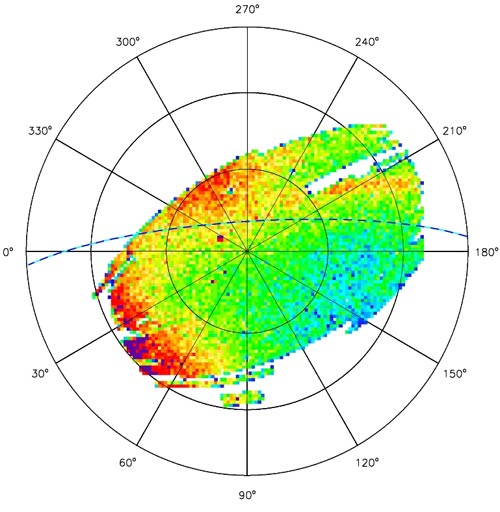Astronomers using a database of some 48 million stars have discovered a faint but huge stellar structure positioned almost directly above the Milky Way’s disk. The most likely interpretation, researchers say, is that this is a dwarf galaxy merging with our own.
“It’s like looking at the Milky Way with a pair of 3-D glasses,” says Robert Lupton of Princeton University, who presented the findings Monday at the American Astronomical Society meeting in Washington. “This structure that used to be lost in the background suddenly snapped into view.”
Data from the Sloan Digital Sky Survey (SDSS), which has mapped about one-quarter of the northern sky, allows astronomers to view slices of the stellar halo surrounding the Milky Way in much the same way as doctors use a medical CT scan. The team used the stars’ colors and apparent brightnesses to infer their distances.
Viewing slices at progressively greater distances from the Sun, the researchers uncovered a dense, starry swath 30,000 light-years away in Virgo. The patch spans 1,000 square degrees, or more than 5,000 times the area of a Full Moon, and contains at least 1 million stars.
“It’s a cloud of stars stuck somewhere above the Milky Way,” Lupton says. The Virgo Overdensity, as astronomers now call it, is “truly a pathetic galaxy,” he says, but it’s so close it spans a greater sky area than any object other that the Milky Way itself. “It’s going to be part of the Milky Way in another million years.”
“Some of the stars in this Milky Way companion have been seen with telescopes for centuries,'” says Mario Juric, a graduate student at Princeton University and the study’s lead author. “But because the galaxy is so close, its stars are spread over a huge swath of the sky, and they always used to be lost in the sea of more numerous Milky Way stars,” he explains. “This galaxy is so big, we couldn’t see it before.”
The first hints of an unusually high density of stars in the direction of Virgo were made in 2001 by the Quasar Equatorial Survey Team (QUEST), which used a 1-meter telescope in Venezuela to study a class of variable stars called RR Lyrae variables.
“We found a clump of 5 RR Lyrae stars and speculated that they belonged to a small galaxy being cannibalized by the Milky Way,” says Kathy Vivas of Venezuela’s Center for Astronomical Research, who published the discovery. “It appears that the stellar stream we detected is itself part of the larger structure identified by Juric and collaborators,” she adds.
Astronomers had long assumed the formation of galaxies like the Milky Way was a slow, steady process that distributed stars smoothly. During the last decade, thanks in part to large surveys like SDSS, QUEST, and 2MASS, astronomers have realized the Milky Way’s structure is more complex than previously thought.
A big surprise came in 1994, when Rodrigo Ibata and his colleagues from Cambridge University, England, discovered the Sagittarius dwarf galaxy as an excess of stars on the far side of the Milky Way, some 75,000 light-years away. The Sagittarius dwarf is slowly dissolving, trailing streams of stars behind it as it orbits the Milky Way and sinks into the galactic disk. Indeed, the plane of the Sagittarius dwarf’s orbit passes near the new structure, which suggests a possible relationship.
“With so much irregular structure in the outer galaxy, it looks as though the Milky Way is still growing by cannibalizing smaller galaxies that fall into it,” Juric says.










